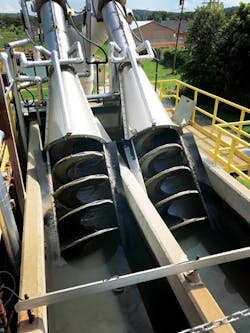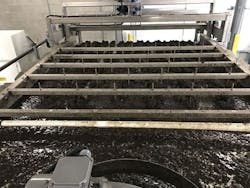About the author: Jim O’Leary is sales and marketing manager for OR-TEC Inc. O’Leary can be reached at [email protected] or 216.475.5225.
A screw auger system transports the dewatered sludge when it is discharged from the belt press to the dump truck.
Given today’s demanding wastewater treatment regulatory landscape, proper handling of sludge is an important component of the design and operation of municipal wastewater treatment plants (WWTP) of all sizes. The mission of any such plant is to separate solids from water, and disinfect both to different degrees by removing organic and inorganic contaminants, which may be hazardous or toxic to humans or have detrimental effects on the environment.
Solid waste, commonly called sludge, typically is comprised of approximately 1.5% solids and 98.5% liquid by the time the biological processing is complete. Removing harmful waste and rendering it safe for reuse or final disposal in landfills or farm field applications is paramount. Therefore, the belt press, which is used to dewater the sludge and change it from a liquid to a solid, is a key element in the wastewater treatment process. For these reasons, the proper handling of sludge is an important component of the design and operation of any WWTP—regardless of municipality or industrial scope.
Biosolids Management
In a progressive effort to adhere to West Virginia’s stringent uniform water treatment regulations regarding land application of treated biosolids, West Virginia’s City of Nitro Waste Treatment Plant (NWTP) sought out a superior solution to its existing belt press. The antiquated system was not performing at optimal levels, did not have the capacity to handle its sludge loading and required excessive system maintenance.
Located between two of the Mountain State’s largest cities—Huntington and Charleston—Nitro originally was born as a “boom town” during America’s mobilization for World War I for production of gun powder. Now celebrating a centennial in 2017, NWTP is nestled near a coal-burning power plant and services approximately 4,500 customers within the region’s population of 7,178.
Having researched belt press system options by visiting a number of installations for nearly three years, Danny Lewis, plant superintendent for NWTP, discovered a suitable belt press system in operation at a wastewater treatment plant in Williamstown, W.V. The plant’s superintendent, Bob Stirling, noted that it was a Gemini belt press from OR-TEC Inc. of Maple Heights, Ohio, an integrated manufacturer of advanced wastewater treatment equipment for the municipal and industrial marketplace.
With previous experience utilizing the manufacturer’s screw screens for a number of years at the inlet of the plant to remove non-organic debris (plastics, rags, sticks, and more), Lewis invited the company to bid on the new system. Matching the specifications from the Williamstown plant operation, the company provided Lewis with a detailed engineered specification proposal that ultimately won it the project.
System Specs
At 2.2-meters wide, the Gemini Series belt press is the largest the company makes and is suitable for a medium-to-large WWTP. The double belt system is constructed of stainless steel due to its performance in wet and corrosive environments. This press combines a gravity drainage zone, a squeezing zone, and a high-pressure shear zone to provide a large dry solids throughput of up to 1,500 lb per hour, low polymer usage, high solids capture rate and an excellent final cake.
The unit has a large flocculation tank with a variable-speed mixer that allows the sludge and polymer solution to be thoroughly mixed. This flocculation process is critical to the dewatering process as it helps separate the water and the sludge; the sludge then forms into small popcorn-sized balls in the water. The variable-speed mixer allows operators to easily change the mixing energy, which helps ensure the best possible flocculation.
Following the flocculation tank, the sludge enters a large gravity zone where plows and a dewatering roller begins the process of thickening the sludge. From here, the thickened sludge enters a low-pressure zone that features a large perforated stainless steel roller followed by an increasing pressure wedge zone. The final dewatering zone is a high-pressure area where multiple rollers of decreasing diameter continue to squeeze and dewater the sludge.
A single control panel is used for all this equipment, and the belt press system also features electric actuation, so no hydraulics or pneumatics are needed. These electrically actuated belt tracking and tensioning systems are controlled by the onboard programmable logic controllers in the belt press panel. Ultimately, this means there is no need to have a separate pneumatic or hydraulic system to operate and maintain tracking and tensioning of the belts.
The manufacturer customized the system to the client’s needs with a range of ancillary equipment via one source, including:
- Polymer dosing feed system. A proprietary component, a mixing tank ahead of the system was added with a flocculation tank that was used in synergy to mix the polymer and sludge prior to sludge thickening or dewatering.
- Wash water pump. A high-pressure pump feeds the spray bars and polymer dosing system.
- Screw auger system. This system transports the dewatered sludge when it is discharged from the belt press to the dump truck.
- Lime feed system. This system adds supplemental lime for the sludge prior to it being land applied. Added lime helps the sludge meet West Virginia’s 20% solids landfill requirement. Lime addition also is beneficial for farmland if sludge is being land applied.
- Sludge cake monitoring system. This add-on feature constantly monitors and detects the sludge being discharged from the belt press. If no sludge is detected for one minute, the entire system shuts down and an alarm is activated.
Optimizing Performance
An integrated belt press system as complex as Nitro’s typically involves a number of third-party suppliers to realize its optimal performance goals. This can be time intensive and complicate installation.
Ultimately, OR-TEC advised and supplied all aspects of Nitro’s system, adding value by working out all of the kinks at every stage of implementation. Some of these variables included troubleshooting wiring of the control panel on the wall, upgrading to the recommended stainless steel at no additional cost and providing conveyers that typically would need to be sourced out. These value-added benefits are particularly important for a smaller plant, as no installation or maintenance crews are required.
Delivered in September 2016, Nitro’s new belt press system has been in operation for months and running at advanced capacity and performance.
“The system handles a lot of throughput, so there is substantially less for operators to deal with on a daily basis,” Lewis said. “There’s no oil, filters or air supply needed so it’s more user-friendly, easier to operate and maintain. If there is any maintenance or service issue, OR-TEC comes in to work out the bugs immediately.”
NWTP’s engineering specification originally called for a minimum of 16% final dry cake—the percent solids in the sludge following dewatering. The Gemini belt press system is exceeding the required production rate requirements, as NWTP is currently achieving a 20%-plus final dry cake standard.
With the system now operating at full potential, Nitro continues to advance its operation this summer by adding two OR-TEC screw screen compactors (OSC7C). Positioned at the inlet of the plant, the screens compress, wash and lift debris to a convenient height for ease of disposal. These units are provided with a perforation size of 6 mm for municipal wastewater. The system is stainless steel (AISI 304 or AISI 316) and can be mounted at an angle in a channel or tank, or supplied for vertical installation.

